In the last half of the 20th century, the southern New England coast and shores of Long Island were peppered with sturdy and simple workboats known as Brockway Skiffs. Designed and built by Earl Brockway of Old Saybrook, Connecticut, these budget-friendly plywood-and-lumber skiffs were ubiquitous in the region and used by professional watermen and recreational fishermen alike. Flat-bottomed and slab-sided, they were generally built in 14′, 16′, or 18′ lengths, and could be built as either skiffs or scows.The boats developed a reputation for being able to carry a load, and they spread around the country and as far as Southeast Asia after the U.S. State Department adopted the Brockway design to aid typhoon-ravaged fishing communities. Built with less-expensive lumberyard-quality wood, roofing tar as adhesive, and galvanized nails, Brockways didn’t usually survive more than two decades, but they were easily replaced. With Earl Brockway’s passing in 1996, the boats’ numbers in the the southern New England coast dwindled, but his skiff still retains a strong cachet with backyard boatbuilders and designers alike, including Walter Baron whose refined Lumber Yard Skiff design has strong ancestral ties to the Brockway. The flat plywood bottom will pound in a chop. Placing the fuel tank forward minimizes the impact by keeping the bow down and minimizing the surface area presented to the waves. Photographs by Jason Pietrzak
Photographs by Jason Pietrzak
Join The Conversation
We welcome your comments about this article. To include a photo with your remarks, click Choose File below the Comment box.

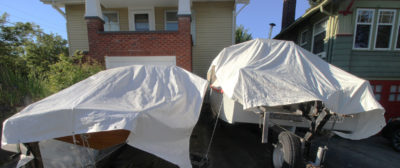
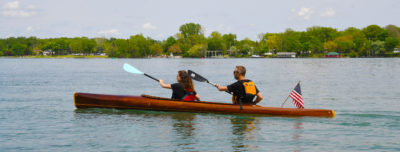

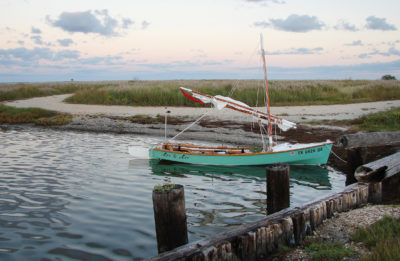
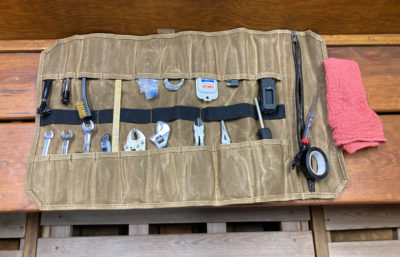
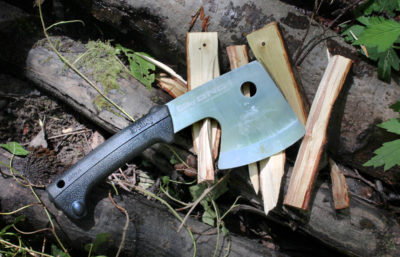
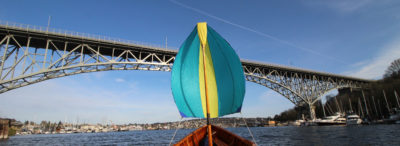
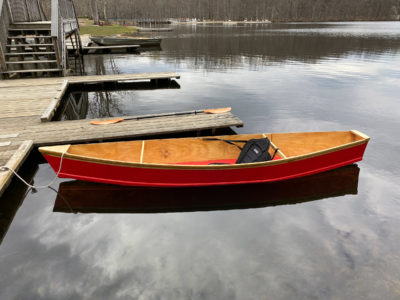

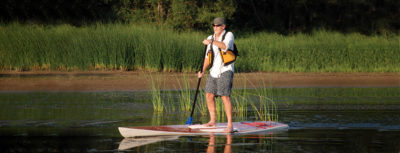

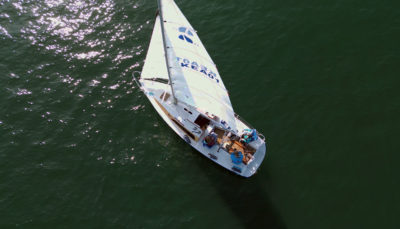
Very nice write up of an archetype, and lovely images, thank you. Simple to build and use, and capable beyond its unassuming appearance. What could be better?
As always, a great article from you, Christophe. What are you sailing these days? GIS to Sea Pearl to Caledonia Yawl to ?????
I am unbelievably boatless right now in terms of sailing cruising craft, but exciting things are on the horizon! Stay tuned!
Bought three boats from Earl, a new England yankee character from another age. In addition to a 12′ skiff for $150, i also bought a 9′ sailboat, including sails (Earl sewed them in cotton), for $140 and a 12′ sailboat including sails for $215 with surround seating. Earl didn’t like to make the larger sailboat, took too much time. I paid him in March to build it, he wouldn’t commit to a delivery time but he did complete it in mid June. He didn’t call, you just had to drop in periodically to check, but not too frequently.
Great memories,
Dick
I had at least five Brockway boats: 14′ scows, 16′ scows, a 16′ skiff, and a 20′ skiff.
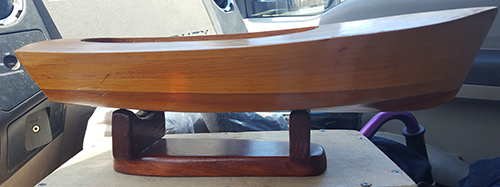
Lobstered and gillnetted bunkers, mackerel in Guilford. (What happened to mackerel?)
Just turn boat over on beach for winter and paint bottom and launch in spring. What a time that was! Still have a miniature hull he sold me when I bought my last boat before he died.
My buddy bought oars he made from ash or something that could row a skiff. I found these notepaper sales slips from Earl dated 1989 and 1996.
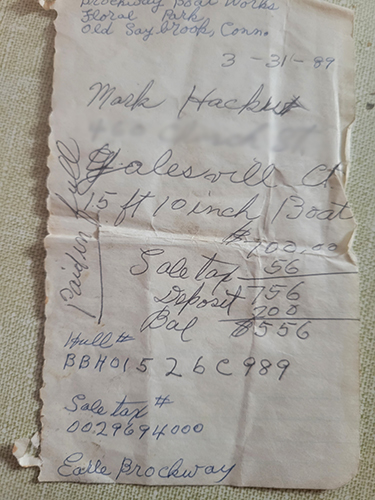
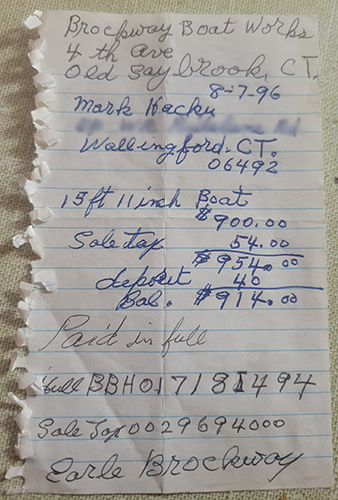
The DMV made him change to regular sales slip form soon after these boats. There was an increase in price, but he needed to put in more flotation, as well as customized seats, and widen the gunwale for balancing pots.
If you worked a boat, turned it over on the beach in winter uncovered, it would last 10 to 12 years. Material was just plywood so it would deteriorate. His way I guess to get return customers. He would deliver a caravan of small skiffs in tow across Long Island Sound to places that would buy and rent them at daily rates for bottom fishing. In Connecticut, customers must have just stopped and picked them up.
I’m sure he had other irons in the fire.
I’m 70 years old now, still fishing. I miss those boats you could bounce off rocks in the Thimbles blackfishing or duck hunting.
Mark Hacku
Grew up in Charlestown R.I., at the Shack on the way to the Breachway. Leon Grinnell was the last of his breed, I have no poetry to do him justice….a man’s man in every way, keeping his living from pond to sea teaching us all what we’d need to know. We dove off his docks daily and off his Brockway often…but I took pride the day he let me steer a line of eelpots in front of his seemingly ancient Johnson 18, and more so when I brought my son from Saybrook to Leon’s. Beginning of different wonderful days. Out in Arkansas, earlier today, I bought a deep green 14’×78″ scow , 15 horse Tohatsu/tiller…..just felt good being close to Leon and Earl among the best of men, from the best of times.
When I was a kid I had several friends that had the larger Brockway boat and we had a blast catching fish out of them. Many of them had British Seagull motors to power them as it was economical but took a while to get out to some of the fishing grounds. Very seaworthy boats in my opinion.
My Dad bought a bunch of Brockway skiffs in the early ’70s, towed them to Block Island from Saybrook and had a small rental fleet along with an 18′ Brockway scow as a garbage-boat business in New Harbor for a few years. I was too young to get involved at the time, but Dad took me to visit Mr. Brockway at his shop when I was in high school in early ’80s. I remember he had on an old pair of sneakers with holes and no socks. It was January with snow on the ground and he was working outside in his yard. There were 2X6s all over the place that he was coaxing to shape by bending them over barrels and other detritus in the yard with heavy weights tied to one end and the other jammed under something stable. That impressed me. I built my first skiff the following summer and will be teaching college students how to build a quick canoe (Michael Storer design) to use for hands-on wetlands conservation research next Fall. Like the other posters and countless others, Earl Brockway is a part of my story and history, and I cherish those memories and the simple, straightforward boats he created.